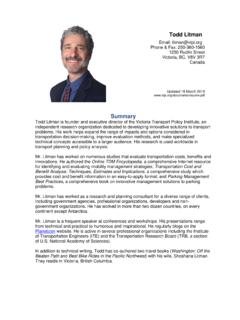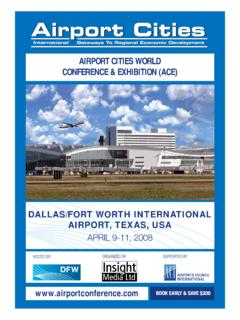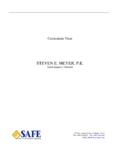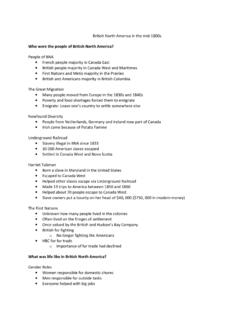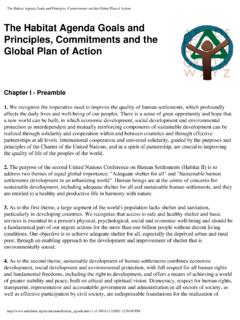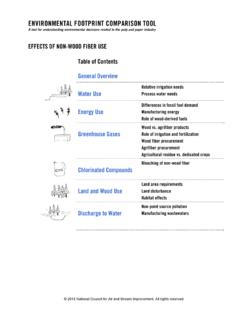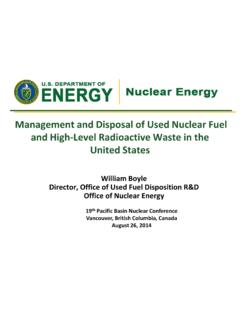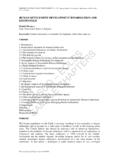Transcription of AIR POLLUTION FROM GROUND TRANSPORTATION
1 AIR POLLUTION FROM GROUND TRANSPORTATION AN ASSESSMENT OF CAUSES, STRATEGIES AND TACTICS, AND PROPOSED ACTIONS FOR THE INTERNATIONAL COMMUNITY by Roger Gorham The Global Initiative on Transport Emissions A Partnership of the United Nations and the World Bank Division for Sustainable Development Department of Economic and Social Affairs United Nations 2002 ii The designations employed and the presentation of the material in this publication do not imply the expression of any opinion whatsoever on the part of the Secretariat of the United Nations concerning the status of any country, territory, city or area, or of its authorities, or concerning the delimitation of its frontiers or boundaries. The views expressed in this document are those of the author and do not necessarily reflect those of the United Nations. Mention of firm names and commercial products does not imply the endorsement of the United Nations.
2 References have, wherever possible, been verified. Reference to dollars ($) are to United States dollars, unless otherwise stated. AIR POLLUTION FROM GROUND TRANSPORTATION AN ASSESSMENT OF CAUSES, STRATEGIES AND TACTICS, AND PROPOSED ACTIONS FOR THE INTERNATIONAL COMMUNITY v CONTENTS Page ix x xi Chapter EXECUTIVE 1 I. TRANSPORT AND 12 II. TRANSPORT AND AIR 2 2 A. Motor vehicle emissions and local ambient air 5 B. Regional and migratory 8 C. Energy consumption and greenhouse 9 III. CAUSES OF AIR POLLUTION FROM 13 13 A. Excessive vehicle use in urban 14 B. Age of fleet and technology 20 C. Poor maintenance of 22 D. Unavailability or improper use of appropriate 22 E. Atmospheric, topological and climatic 23 IV. STRATEGIES TO ADDRESS AIR POLLUTION FROM 23 A. Technical 23 B. Systemic 31 C. Behavioural 32 D. Balancing global and local 40 V.
3 TOOLS AND TACTICS FOR 41 41 A. Targeting fuel consumers: pricing 42 B. Targeting motor vehicle users: pricing other variable costs of motor vehicle 43 C. Targeting motor vehicle operators: changing driving conditions and managing 43 D. Targeting travellers and shippers: influencing travel 44 E. Targeting vehicle purchasers: influencing vehicle fleet demand and 45 F. Targeting motor vehicle manufacturers and importers: influencing vehicle fleet 46 CONTENTS (continued) Page vi G. Targeting vehicle owners and fleet managers: improving in-fleet vehicle 47 H. Targeting fuel refiners and importers: influencing the fuel 47 I. Targeting developers and planners: influencing the built 48 J. Targeting households and firms: influencing location 49 K. Targeting the general public: influencing public attitudes towards 49 VI. THE INTERNATIONAL 49 A. Ongoing mechanisms of international 50 B.
4 Further support from the international 56 LIST OF TABLES Share of fossil fuel combustion by the transport sector for selected 4 Proportion of emissions due to vehicles in selected cities and 7 Increases and growth rates of transport sector carbon dioxide (CO2) 10 Areas of application of vehicle technology for internal combustion engine (ICE) 26 LIST OF FIGURES Level of population s exposure to POLLUTION by world region and per capita energy consumption by world 3 Pathway from transport emission to health 6 Past and projected emissions of carbon dioxide (CO2) from the transport 10 The transport sector s past and projected share of carbon dioxide (CO2) emissions by 11 Regional proportions of total transport carbon dioxide (CO2) 12 ASIF decomposition for 15 ASIF decomposition for the United 16 Car penetration levels at given levels of per capita 17 Relation between vehicle ownership and income in the economies in transition compared with Western 18 Annual car use at given levels of per capita 18 Pathways to excessive car 21 LIST OF BOXES Economic considerations in strategic 24 Energy efficiency and aggregate demand: the rebound 25 Best practice in transport/land-use 38 LIST OF ANNEXES I.
5 Primary and secondary pollutants from the transport 65 II. Excessive vehicle 75 III. Conventional vehicle technology 79 CONTENTS (continued) Page vii IV. Alternative vehicle 83 V. Addressing the in-use 96 VI. Fuel specification and 101 VII. Network effects: speed, flow, and induced 106 VIII. Economic analysis in urban air quality 113 IX. Fuel pricing for environmental 116 X. Menu of tactical 120 LIST OF ANNEX TABLES Tolerated levels of lead use in gasoline specifications, by world 66 Estimates of external costs of road transport as a percentage of national/regional 78 Areas of application of vehicle technology for ICE 79 GREET assessment of reduction in emissions from CNG relative to conventional gasoline ICE 89 GREET assessment of reduction in emissions from LPG relative to conventional gasoline ICE 90 GREET assessment of reduction in emissions from ethanol and methanol relative to conventional gasoline ICE 91 GREET assessment of reduction in emissions from electric propulsion cars relative to conventional gasoline ICE 94 GREET assessment of reduction in emissions from synthetic fuels relative to conventional gasoline ICE 95 Cost-effectiveness of different incentives in the Vancouver scrappage 100 Various estimates of vehicular travel elasticities with respect to travel 111 Various estimates of vehicular travel elasticities with respect to lane 111
6 Various estimates of the share of vehicular travel attributable to induced 111 Comparative prices of gasoline and diesel in countries of the former Soviet Union and Eastern Europe, as well as France, Germany, the United Kingdom and the United 118 Transport emission reduction measures: tactical targets and strategies 121 CONTENTS (continued) Page viii Price comparison of car-sharing and taxis in 125 Feebate options evaluated in Europe and North 130 Schematic of proposed feebate structure in 130 LIST OF ANNEX FIGURES Proportion of population living in a country with leaded gasoline, by 66 Relative problem of particulate matter in world 70 Relative problem of ozone in world 71 Relative problem of NO2 in world 72 Relative problem of CO in world 73 Relative problem of SO2 in world 73 Isopleth of NOx and VOC contribution to ozone 74 Proportion of infrastructure and external costs recovered by European rail and road 76 GHG emissions of various fuels from different points of the energy 84 Alternative production pathways for various 84 Deterioration of NMHC emissions factors for tier I light-duty 97 Octane enhancements versus lead concentration for some typical 102 Speed correction factor for VOC emissions from light-duty 106 Speed correction factor for fuel efficiency for light-duty 107 Time-speed emissions traces for carbon monoxide for an average driver and an aggressive driver in an 11-km trip from 108 Time-speed emissions traces for volatile
7 Organic compounds for an average driver and an aggressive driver in an 11-km trip from 109 Elements of air quality management 114 emission standards in Japan, the European Union and the United States, 132 References .. 142 ix Foreword There is a growing awareness of the importance of the transport sector to efforts aimed at achieving sustainable development and it was considered in detail at the ninth session of the Commission on Sustainable Development held in April, 2001. Transport poses a dilemma in that it is necessary for economic and social development, yet it is associated with environmental degradation, especially with regard to atmospheric POLLUTION . The transport sector accounts for about 25 per cent of total commercial energy consumed worldwide, and consumes approximately one-half of total oil produced. Its emissions include GreenHouse Gases, most notably CO2, as well as particulate matter, lead, nitrogen oxides, sulfur oxides and volatile organic compounds all of which have negative impacts at local and often at regional levels.
8 In addition, it is associated with adverse noise and land use impacts. Demand for transport services is expected to grow considerably as economic growth occurs in developing countries, incomes rise, the trend toward urbanization continues and as the process of globalization moves forward with expected increases in world trade. Between now and 2020, demand is forecasted to grow by percent per year in developing countries and by percent per year in industrialized countries. Decisions taken to meet this demand are often long-term in nature and those today will affect our ability to achieve sustainable future in years to come. Transport remains an important area of consideration as the international community prepares for its tenth year review of progress made to achieve sustainable development at the World Summit on Sustainable Development (Johannesburg, 2002).
9 This report was prepared as an input to deliberations on transport-related issues by the international community and as part of the activities of the joint United Nations/World Bank project entitled Global Initiative on Transport Emissions (GITE). An earlier version of this report was presented at the ninth session of the Commission on Sustainable Development, and the report presented here reflects comments and inputs received during that session. We would like to express our appreciation to the author of the report for his considerable time and effort, to the World Bank for its continued cooperation and support, and to those who participated in the review process. It is hoped that this report contributes to efforts to achieve sustainable development in the transport sector by the international community and provides information and guidance to policy makers in both developed and developing countries. JoAnne DiSano Director Division for Sustainable Development Department of Economic and Social Affairs United Nations x ACKNOWLEDGEMENTS The author wishes to thank the many individuals have who offered assistance and advice during the preparation of this report, including: Byron Bunker of the United States Environmental Protection Agency, Ed Dotson, Gunnar Eskeland, Ken Gwilliam, Masami Kojima, Zmarak Shalizi, George Tharakan, and Chris Willoughby, all of the World Bank, and Mike Walsh, independent consultant.
10 Special thanks are due Chris Weaver of Engines, Fuels and Emissions Engineering, Inc., for being a patient fount of information. Ken Gwilliam and Masami Kojima reviewed the entire document and their efforts are especially appreciated. The author also thanks Jessica and Tim Rockwood for their solid moral support. xi ABBREVIATIONS ACEA Association of European Motor Vehicle Manufacturers AIJ activities implemented jointly ALS Area Licensing Scheme AQMS air quality management system ASIF activity, structure, intensity and fuel BAU business as usual BRT bus rapid transit CAFE corporate average fuel efficiency (United States) CAP Compliance Assurance Program CBD central business district CDM Clean Development Mechanism CERs Certified Emissions Reductions CH4 methane CNG compressed natural gas CO carbon monoxide CO2 carbon dioxide CONCAWE European oil industry organization for environment, health and safety CONPET National Programme for Rationalization of the Use of Petroleum Derivatives and Natural Gas (Brazil)










